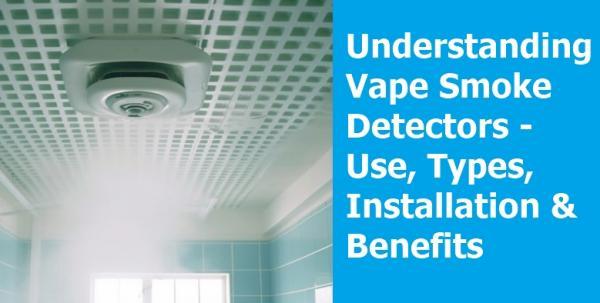Understanding Vape Smoke Detectors: A Comprehensive Guide

In recent years, vaping has become popular among young adults & teenagers as an alternative to traditional cigarette smoking due to the variety of flavors and less odors. Nevertheless, it has also raised concerns for health, safety, and property protection. In response, the market for vape smoke detectors has emerged, providing solutions for detecting vape smoke in various environments. In this article, we’ll dive into what vape smoking detectors are, how they function, their benefits, and why they are important for homes and businesses.
What is a Vape Smoking Detector?
A vape smoking detector is a specialized device designed to detect the presence of vapor from vaping devices and e-cigarettes. Unlike traditional smoke detectors, which are primarily focused on detecting smoke from burning materials, vape detectors are engineered to sense the chemical components found in vapor, such as propylene glycol and vegetable glycerin, as well as nicotine and other additives.
Types of Vape Detectors
There are several types of vape detectors available on the market:
- Standalone Vape Detectors: These are independent battery-operated units designed solely for detecting vape smoke. They can be installed in various locations, such as classrooms, restrooms, and other public areas.
- Integrated Smoke Detectors: Some types of smoke detectors are equipped with vape detection capabilities. This dual functionality allows them to detect both traditional smoke and vape emissions, providing wide coverage range.
- Smart Detectors: Many vape detectors can connect to smart home systems, sending alerts directly to your smartphone or route to central hub/gateway when vape activity is detected. These detectors often feature advanced electrochemical sensors for more accurate readings.
How Do Vape Smoking Detectors Work?
Vape smoking detectors operate using a combination of sensors and algorithms to find presence of vapor. Here’s a breakdown of the working mechanism:
- Chemical Sensors: Most vape detectors have built-in chemical sensors that can identify specific compounds found in vaping. These sensors can distinguish between fine vapor mist and traditional burning smoke which help reduce false alarms.
- Particle Detection: Some detectors make use of particle sensors that can detect small particles produced during vaping. When the vapor is exhaled by the person, the particles can trigger the detector, alerting users of the presence of vaping in the area.
- Smart Technology: Advanced vape detectors may include Wi-Fi/Zigbee or other wireless connectivity, allowing users to receive real-time notifications on their devices. These smart detectors often come with mobile apps that enable users to monitor remotely.
Benefits of Using Vape Smoking Detectors
Installing vape smoking detectors offers numerous advantages for buildings:
- Health and Safety Protection
Vaping can pose health risks, especially to seniors, pregnant women or children who are more prone to experience adverse effects. Vape detection in confined spaces can monitor and manage vaping activities, ensuring a healthier environment for occupants.
- Fire Protection & Hazard Prevention
While vaping is generally considered safer than traditional smoking, the vape fluid is still flammable & generates heat which can present fire hazards. Detecting vape emissions early can prevent potential fire incidents.
- Promoting a Smoke-Free Environment
Implementing vape detectors supports school, hospital or workplace policies aimed at maintaining a smoke-free environment. The presence of these detectors can deter individuals from vaping in prohibited areas and encourage compliance with regulations.
Where to Install Vape Smoking Detectors
To maximize the effectiveness of vape smoking detectors, the device are placed strategically in key indoor areas. Here are some recommended locations:
- Schools
Install vape detectors in hallways, classrooms and washrooms to monitor and enforce anti-vaping policies.
- Workplaces
In office environments, place detectors in lunch area, restroom and near entrances where employees may be tempted to vape.
- Public Spaces
Install vape detectors in public buildings such as libraries, community centers, and recreational facilities to foster a healthy environment.
- Residential Properties
For homes with teenagers or frequent guests, consider placing detectors in common areas, bedrooms, and near entry points.
Choosing the Right Vape Smoking Detector
When selecting a vape smoking detector, consider the following factors:
- Detection Technology
Look for detectors that use advanced detection technologies, such as chemical sensors and particle detection, for accurate measurements.
- Integration Capabilities
If you already have a security, fire alarm or smart home system, choose a vape detector that can integrate seamlessly with your existing systems for enhanced monitoring.
- User-Friendly Features
Prioritize detectors with interfaces that are easy to understand and online connectivity for real-time notifications and monitoring.
- Regulatory Compliance
Ensure the detector meets local and national standards and regulations regarding safety and emissions detection in commercial & residential settings.
Conclusion
As vaping continues to gain popularity, the need for effective monitoring solutions becomes paramount. Vape smoking detectors provide a proactive approach to maintaining health and safety in public or private settings. Investing in a reliable vape smoking detector not only protects your property but also fosters a culture of health and safety. By understanding the importance of these detectors and making informed choices, everyone can contribute to a safer, more responsible environment for everyone.
Additional Resources
For more information on vape smoking detection & fire protection, consider checking out the following resources for related information:
- National Fire Protection Association (NFPA)
- Consumer Product Safety Commission (CPSC)
- Centers for Disease Control and Prevention (CDC)
For any product inquiry or development projects, please contact one of our specialists for more information.

